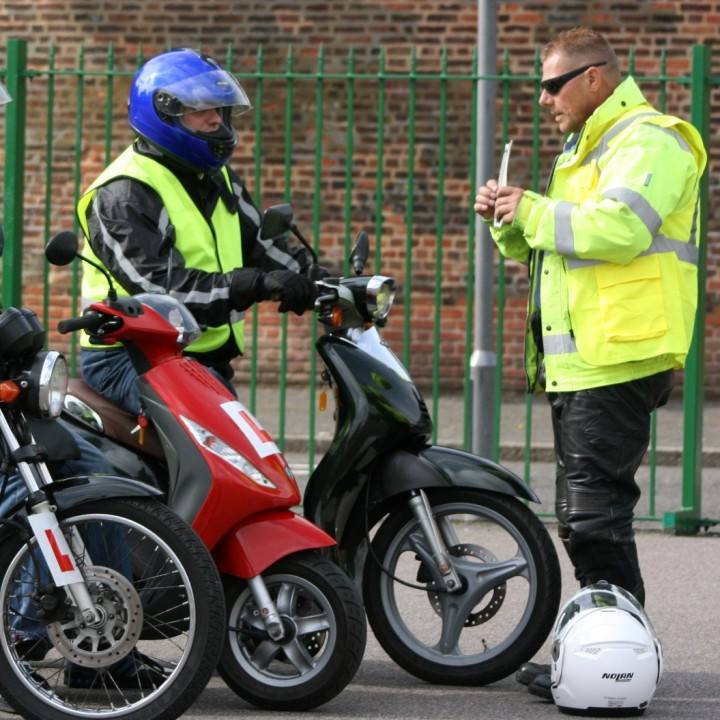
Module 1
Off-road test: what happens
Moto-pass Motorcycle Training covers module 1 training along with module 2 training and all other elements of learning to ride a motorcycle safely. You’ll take the module 1 test in an off-road motorcycle manoeuvring area.
The test normally takes about 20 minutes and includes:
- wheeling the moped or motorcycle and using the stand
- riding a slalom and figure of 8
- a slow ride
- a U-turn
- cornering and a controlled stop
- cornering and an emergency stop
- cornering and hazard avoidance
For the hazard avoidance and emergency stop exercises you must ride at a minimum speed of:
- 19 mph on a moped
- 31 mph on a motorcycle
Your test result
You’ll be told if you’ve passed module 1 at the end of the test. The examiner will make a note of:
- dangerous faults – these involve actual danger to you, the examiner, the public or property
- serious faults – these are potentially dangerous
- riding faults – these are not potentially dangerous, but could become serious if you keep making the same mistake
You’ll pass module 1 if you make:
- no serious or dangerous faults (sometimes called ‘majors’)
- no more than 5 riding faults (sometimes called ‘minors’)
If you pass
The examiner will:
- tell you what faults you made, if any
- give you a pass certificate – you need to take this to the module 2 test
Module 2
On-road test: what happens
The second module of the test usually takes around 35 – 40 minutes and is on public roads covering a range of road and traffic conditions. A DVSA examiner will follow you for this period.
At Moto-pass, we specialize in creating courses that most suit your ability and learning style. The best way to ensure you book the correct course is to talk to one of our fully trained call centre staff. They’ll be able to guide you through the best options for you based on your current level of experience and your availability.
Motorcycle licence training days are typically full 6 hour days. Licence test days are normally 2.5 to 3 hours. However, test timings and training requirements do vary from student to student.
Moto-pass Motorcycle Training courses cover both Module 1 and Module 2 training elements. We fully prepare you to become a safe and competent rider for UK roads.
You must pass Module 1 before you can take the Module 2 test.
You can book both modules at the same time, but if you do not pass module 1 you must wait 3 working days before you can retake it.
The module 2 test normally takes about 40 minutes and includes:
- an eyesight check
- ‘show me, tell me’ vehicle safety questions
- road riding
- independent riding
You must bring your module 1 pass certificate to the module 2 test, plus all the documents you had to bring to the module 1 test.
Eyesight check
You’ll have to read a number plate from a distance of:
- 20 metres for vehicles with a new-style number plate
- 20.5 metres for vehicles with an old-style number plate
New-style number plates start with 2 letters followed by 2 numbers, for example, AB51 ABC.
You’ll fail your riding test if you fail the eyesight check.
‘Show me, tell me’ questions
Road riding
You’ll drive in various road and traffic conditions, but not on motorways. You’ll be asked to carry out:
- normal stops
- an angle start (pulling out from behind a parked vehicle)
- a hill start (where possible)
The examiner will give you directions using a radio. They’ll normally follow you on a motorcycle.
Driving test routes are not published, so you can not check them before your test.
Your test result
You’ll be told if you’ve passed module 2 at the end of the test.
The examiner will make a note of:
- dangerous faults – these involve actual danger to you, the examiner, the public or to property
- serious faults – these are potentially dangerous
- riding faults – these are not potentially dangerous but could become serious if you keep making the same mistake
You’ll pass module 2 if you make:
- no serious or dangerous faults (sometimes called ‘majors’)
- no more than 10 riding faults (sometimes called ‘minors’)